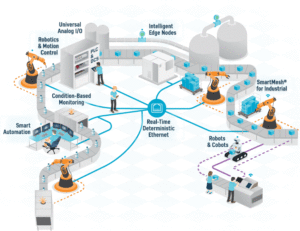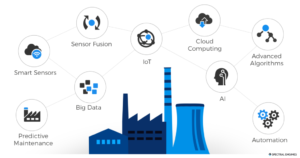 Industry 4.0, as we saw in the previous blog, is a radically different approach to manufacturing. It makes use of a collection of next-gen technologies to solve the problems that business owners face today. It enables collaboration across the organization, provides access to real-time data, and can derive insights from a vast amount of data for process optimization.
Industry 4.0, as we saw in the previous blog, is a radically different approach to manufacturing. It makes use of a collection of next-gen technologies to solve the problems that business owners face today. It enables collaboration across the organization, provides access to real-time data, and can derive insights from a vast amount of data for process optimization.
In the first (Industry 4.0 an Overview) of a series of blogs on Industry 4.0, we took a glimpse into what Industry 4.0 means and the underlying technologies that make it up. Here, we shall try and imagine how an Industry 4.0-enabled company shall manufacture its products.
Let us look at five examples of how tomorrow’s manufacturing shall be completely different from the way it is today. Hope you find it interesting!
1. Simulation of the design process
Companies of the future shall save on manufacturing time and rework costs by testing designs in the virtual world pre-production. The entire design process and assembly line shall be simulated to analyze, beforehand, the errors/issues that may crop up later. New tools that allow such simulations shall help deliver exactly what the companies intend to create. Following are some examples of the questions companies try to answer using simulations:
- Will adding new machines on the shop-floor increase our throughput or create unexpected bottlenecks?
- Should we introduce a new product line? Will that lead to us failing to meet the production goals?
- At what point in the production cycle are the most number of defects occurring? What changes on the shop-floor help us improve?
2.Collaboration through AR/VR
Currently, companies spend a significant amount on sending an engineer over long distances (in many cases, overseas) for maintenance and trouble-shooting at a client or partner’s site. And, they would definitely jump on a solution that saves such costs. Enter Augmented Reality (AR). AR shall allow people in different locations around the globe to connect and trouble-shoot on manufacturing issues together. As a result, an engineer in Japan can consult with an engineer in the U.S. and also receive feedback in real-time.
3.Additive manufacturing
Almost all of the current manufacturing is based on subtractive processes, i.e., the material is removed from the whole to create the required parts. However, with additive manufacturing (AM), parts shall be made by adding layers over one another.
AM, commonly called 3-D printing, is making a mark globally and is poised for exponential adoption. It shall provide several benefits to the manufacturer, such as:
- Requirement of a single machine to create a product
- Increased possibilities for the design of parts
- No additional process like welding or screwing required
- Reduced waste
- Reduced cycle times and faster throughput
4.Manufacturing on auto-pilot
Automation, even today, is adopted to a large extent  for automating a lot of tasks. However, going forward, more and more complex, precision-oriented, and tasks performed in harsh environments shall be taken over by a robot. Robotics and automation provide several benefits. First and foremost, they provide a level of accuracy and productivity that is beyond human ability. Secondly, robots perform a given task in the most precise manner – nothing more, nothing less. And finally, companies can leverage robots to increase their outputs.
for automating a lot of tasks. However, going forward, more and more complex, precision-oriented, and tasks performed in harsh environments shall be taken over by a robot. Robotics and automation provide several benefits. First and foremost, they provide a level of accuracy and productivity that is beyond human ability. Secondly, robots perform a given task in the most precise manner – nothing more, nothing less. And finally, companies can leverage robots to increase their outputs.
The new generation of robotics is becoming increasingly simpler to implement and use. Hence, their benefits can be reaped not just for manufacturing but also for the storage and transport of goods. (Check out Yantra’s line of Robotics products here)
5.Building intelligent factories – in the cloud
Adopting ‘digital’ and smart sensors to track crucial information on the shop-floor (Internet of Things) shall lead to a greater demand for data storage and analysis. Cloud computing shall enable companies to achieve precisely this. It shall help store large amounts of data without investing in real-estate and perform advanced analysis on it.
Analysis of data gathered from the production line and customer feedback shall positively impact research and development and help deliver exactly what the customers want. Hence, it can be said that the factories of tomorrow shall be active ‘in the cloud’ as much as on the ground.
Conclusion
Thus, we have looked at five compelling examples of how the manufacturing of tomorrow looks like. Quite simply, radically different from the way it is today. With the adoption of the aforementioned technologies, companies shall produce more at lesser costs, thus increasing their profits.
We, at Yantra, are enthusiastic about the future and how manufacturing shall evolve. We are committed to incorporating advanced technologies in our products to provide unique benefits to our customers.
Stay tuned to our Knowledge Corner as we, next, look at how you can start your journey of becoming Industry 4.0 enabled.



